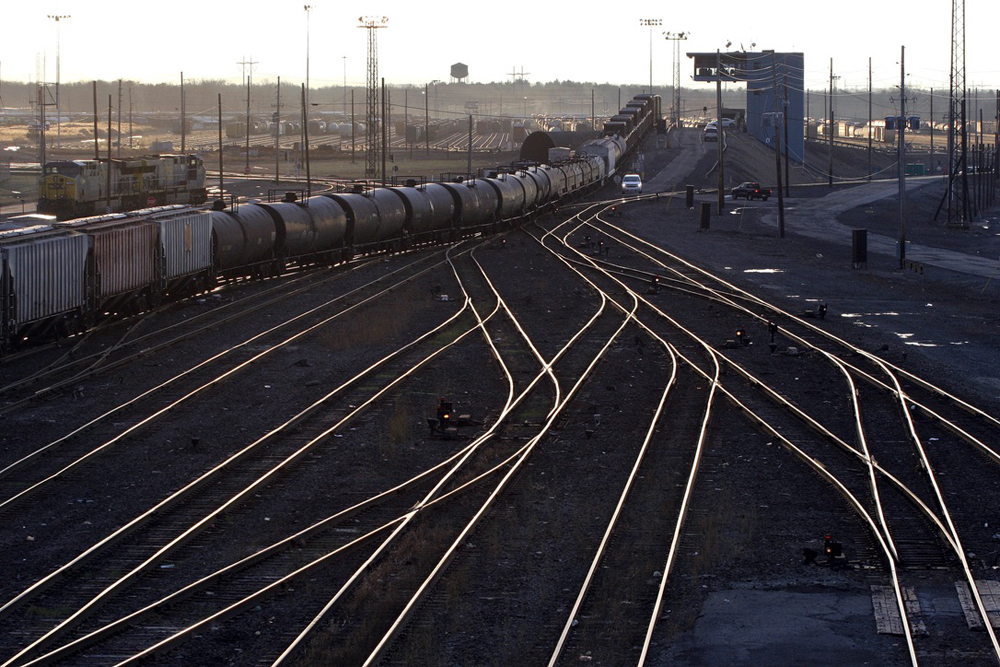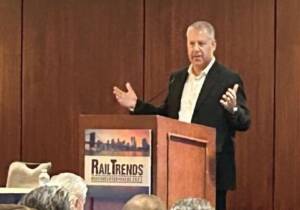
All of the Class I railroad CEOs say that providing more reliable and consistent service is the key to volume growth. So did they applaud when federal regulators proposed minimum service standards that railroads would have to meet in order to avoid potential reciprocal switching orders? Not exactly.
In a nutshell, the Association of American Railroads says there are so many factors outside of railroads’ control that it is simply impossible to prevent service problems. And the AAR adds that measuring on-time performance, variations in transit times, and local service quality are poor ways to judge the level of service railroads are providing to their customers.
As they say in passenger stations, mind the gap.
Railroads can’t have it both ways. They can’t make reliable, consistent service the cornerstone of the volume growth plans they’re selling to shippers and investors while at the same time telling regulators that being an outdoor factory and part of an interdependent network means that service will always be highly variable.
At issue: The Surface Transportation Board in September proposed a rule that would allow shippers located in terminal areas to seek access to a second railroad via reciprocal switch if the serving carrier failed to meet any one of three performance standards over a 12-week period. Railroads risk a reciprocal switch case if:
- They don’t deliver at least 60% of cars within 24 hours of the original estimate
- Average transit time increases by 20% to 25% compared to the prior year
- Their success rate for spotting and pulling cars within a given service window falls below 80%
The standards set a pretty low bar, particularly when trucks provide 95% on-time performance. Plus, the proposed rule includes an important loophole for service failures that are beyond a railroad’s control, such as harsh weather or the actions of third parties.
Earlier this month the AAR and each Class I railroad weighed in on the proposal. The AAR says that railroads have every incentive to provide excellent service. And AAR agrees that shippers should be able to access a second railroad if the serving carrier can’t fix an ongoing service problem; the reciprocal switch is safe, workable, and would improve service; and the shipper has a compelling reason for receiving alternative service.
But the AAR argues that the performance standards should not apply to traffic that moves under contract or to commodities that are exempt from STB regulation. This would make the service standards apply to only about 5% of rail traffic. What this tells you is that railroads don’t want to be held accountable for the service they provide.
Among AAR’s more absurd arguments against service standards:
“One point of particular concern is that an observed decline may be the product of comparing a prior year’s new or exceptional service produced through enhanced investment, to a current year’s solid (but less stellar) performance when the carrier’s resources were spread to other shipments. Ordering a switch in this circumstance could disincentivize the carrier from making future investments in service improvements.”
“Despite the Board’s assurances that it does not wish to discourage increased local service levels that set a higher baseline against which a future reduction in service levels might be measured, adoption of this metric would understandably make railroads more cautious to experiment with increased local service levels.”
In other words, setting minimum service standards will actually hinder service improvements that could lead to the growth that will produce higher revenue and profits. Uh-huh.
The most disappointing response to the service standards proposal came from CSX. Among its points:
“The rail network is never static, and any metric will fluctuate regularly, particularly on a lane-by-lane basis. Given this dynamic, the [proposed rule’s] mechanical approach is ill-suited to identify service problems that could be remedied by a forced switching arrangement.”
“A single measure cannot determine whether a customer is receiving good service.”
“The … proposal that a single metric trigger would be conclusive evidence of service inadequacy creates incentives against maintenance or capacity expansion projects designed to improve service over the long run (because those same projects could produce short-term metric dips).”
“A rigid focus on a single metric could also disincentivize changes to operating plans that decrease transit times or increase days of service, because the railroad would just be setting a higher performance bar for the future.”
“While CSXT supports the Board’s efforts to refine service metrics, there is no perfect quantitative way to reliably divide service successes from service failures.”
“The network is simply too complex, and the needs — and reciprocal responsibilities — of rail customers are too diverse for the Board to predetermine either a particular percentage threshold that would mark the divide between good and bad service.”

This is ironic. CSX CEO Joe Hinrichs this month delivered an eloquent, refreshing, and spot-on speech arguing that railroads need to up their game. In order to grow, railroads must raise their expectations, work more closely together, and make customers want to do business with them, Hinrichs told the RailTrends conference just 10 days after the railroad submitted its response to the STB reciprocal switching proposal.
Hinrichs isn’t satisfied with the railroad’s 88% trip plan compliance figure for the year to date, which sits well above the STB’s service standards proposal. “That’s not great. It’s good for an industry like ours. It’s not great. It’s better but it’s not great,” he says. “We have to set ourselves to higher standards. If we don’t do it, the only one left to do it is the regulators.”
He adds: “We have to challenge ourselves not to just be OK. That’s not motivating. I don’t want to come home to my Mom and say, ‘Man I got a 70 on my test. It’s great!’ That’s not great,” he says.

“Every single CEO that was here last year talked about growth. How’s that working? We’re a year later, how’s it working? I can tell you one railroad that’s grown merchandise volume this year, the only one. Three letters, starts with a C,” Hinrichs says. “Why is that? Because we delivered better service. We won business because of better service. I didn’t say great. I said better. Words matter.”
Hinrichs, a former Ford Motor Co. executive who was once a rail customer, is right. And give some credit to BNSF Railway, too. Despite arguing that the metrics shouldn’t apply to contract shipments or exempt commodities, BNSF otherwise generally supported the STB proposal.
While railroads quibble over how low the service bar should be set, shippers have been judging rail service all along — and they don’t like what they see. They’ve been voting with their feet by shifting their business to trucks.
You can reach Bill Stephens at bybillstephens@gmail.com and follow him on LinkedIn and X @bybillstephens














Good writeup Bill, thanks for injecting some much-needed rationality into this discussion about current railroad service standards. Especially in light of the fact that Trains’ staffers and most in the railroad press have been complete milksops when it comes to PSR and calling out the ongoing deterioration of service and reliability therefrom (even the great Fred Frailey was all starry-eyed with EHH at first and only somewhat changed his mind about PSR well into the game when even casual fans could see the damage much earlier). As we all know, monopolies and quasi-monopolies tend to have such influence and need more regulation than so-called normal “market forces” exert to do what they’re supposed to. I have to wonder if complete abandonment by all customers and no business at all would even make them change their minds about changing their current ways? Some would quickly say that the overregulation by the ICC for way too long nearly ruined the business, but think of service quality back in the days of much less profitability: Passenger trains everywhere that ran on time, staffed with people that cared and knew how to deliver service. Late performance was simply not tolerated. As well, lots of frequent freight service that generally was way better than today, with lots more trains along lots more lines to lots more places and users with plenty of needed support staff, etc., that usually ran on time. Plenty of money was still made, including by union men in bigger crews, besides the usual mangagement takers. How could this be? What has been lost? The answer would fill libraries. I really have to wonder if the post-Staggers pendulum has swung too far the other way to a near-complete abandonment of any real enforceable oversight and has resulted in a quicker and easier path to railroad extinction, irrelavance at least, than any ICC-regulated pathway would have led?
Injuns
So let me get this straight. Are these railroads actually arguing that they will allow their service to deteriorate if forced to meet minimum standards? That’s what it sounds lie to me. Can you imagine Swift or JB Hunt telling their customers “If you try to hold us to our delivery promises we’ll take twice as long to get your shipments to you?” Talk about shooting yourself in the foot.
Put another way, if the FRA is trying to set mimimum standards for you then you’re doing something wrong.
“BNSF otherwise generally supported the STB proposal.”
LOL. Just after fighting with the STB over a coal CONTRACT that they weren’t delivering on. Talk about normalizing mediocrity.
Class 1’s speak with forked tongue. Say growth to Wall Street to keep them off their case, but reject service standards that would at minimum provide a baseline by which service could be measured. Hinrichs doesn’t have a whole lot of room to talk. Ford has been barking quality since time eternal, yet they still struggle to get cars made on time and on budget with any sense of quality. So at this point he is playing to the crowd like a good politician.
A(nother) excellent article, Bill. But what did CN’s Ed Harris say but a few days ago, “Just run the trains on time?” Why are CSXT and AAR making this so hard?
Possibly the objection to applying these standards to contract rates would be modified or eliminated if there were added the clause “except in cases where a performance standard has been set in the contract.”
The RRs have to oppose these standards. Otherwise, the Wall street guys will have their heads. Almost everyone realizes that these standards mean more T&E, more locos, & more loco maintenance. As well some more track infrastructure. That will raise the OR.
Do the managements of all RRs secretly hope for raising the standards? That means a long term gain that Wall Street is not interested in.
One item not mentioned in these standards is what should the standard be for either renewing dropped service or even starting new service to shippers and receivers.